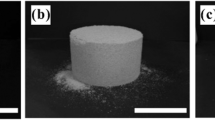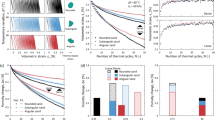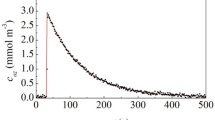Abstract
Smalley and Smalley1 have commented on a theoretical expression for the tensile strength of an ideal granular material (in the pendular stage of moisture distribution), due to Rumpf2, and have proposed an alternative approach. Their final equation 10a, namely,  (where B is the interparticle force per contact, D is the diameter of the particles, and t is the thickness of the fracture zone), includes in the constant term the value of the co-ordination number, k. The authors quote a value k = 8.5, taken from data published by Bernal and Mason3; my re-examination of these data (given in Table 1, ref. 3) indicates that the value should be k = 8.0, which makes a proportionate change in the constant of equation 10a. While equation 10a is dimensionally consistent, the authors' intuitive reasoning in their final paragraph1 would seem to require that σ be inversely proportional to D2 and not D3, as the number of bonds in a section of constant size is inversely proportional to particle cross-section, and not volume; in this respect, Rumpf's equation σ ≊ 2B/D2 is more plausible, though of rather academic interest. Rumpf2 measured the tensile strengths of limestone pellets, and found that as moisture content decreased, so also did the strength, contrary to his theoretical expectations for the pendular state. I have determined the tensile strengths of various size fractions of a fine coal, using a split cylinder method. Fig. 1 illustrates some typical results, which show a trend similar to that found by Rumpf for limestone.
(where B is the interparticle force per contact, D is the diameter of the particles, and t is the thickness of the fracture zone), includes in the constant term the value of the co-ordination number, k. The authors quote a value k = 8.5, taken from data published by Bernal and Mason3; my re-examination of these data (given in Table 1, ref. 3) indicates that the value should be k = 8.0, which makes a proportionate change in the constant of equation 10a. While equation 10a is dimensionally consistent, the authors' intuitive reasoning in their final paragraph1 would seem to require that σ be inversely proportional to D2 and not D3, as the number of bonds in a section of constant size is inversely proportional to particle cross-section, and not volume; in this respect, Rumpf's equation σ ≊ 2B/D2 is more plausible, though of rather academic interest. Rumpf2 measured the tensile strengths of limestone pellets, and found that as moisture content decreased, so also did the strength, contrary to his theoretical expectations for the pendular state. I have determined the tensile strengths of various size fractions of a fine coal, using a split cylinder method. Fig. 1 illustrates some typical results, which show a trend similar to that found by Rumpf for limestone.
This is a preview of subscription content, access via your institution
Access options
Subscribe to this journal
Receive 51 print issues and online access
$199.00 per year
only $3.90 per issue
Buy this article
- Purchase on Springer Link
- Instant access to full article PDF
Prices may be subject to local taxes which are calculated during checkout
Similar content being viewed by others
References
Smalley, V., and Smalley, I. J., Nature, 202, 168 (1964).
Rumpf, H., Agglomeration, 379 (Interscience Publishers, 1962).
Bernal, J. D., and Mason, J., Nature, 188, 910 (1960).
Tanaka, T., Gotoh, K., and Shinohara, K., Mineral Processing, 32 (March 1966).
Fisher, R. A., J. Agric. Sci., 16, 492 (1926).
Cross, N. L., and Picknett, R. G., Proc. Int. Conf. on Mechanism of Corrosion by Fuel Impurities, Marchwood, May 1963 (Butterworths, 1963).
Mason, G., and Clark, W., Nature, 207, 512 (1965).
Author information
Authors and Affiliations
Rights and permissions
About this article
Cite this article
CARR, J. Tensile Strength of Granular Materials. Nature 213, 1158–1159 (1967). https://doi.org/10.1038/2131158a0
Received:
Published:
Issue Date:
DOI: https://doi.org/10.1038/2131158a0
This article is cited by
-
A Critical Conception of Hot-Tearing Susceptibility: Shape Casting with Wrought Aluminum Alloys
International Journal of Metalcasting (2022)
-
Tensile stress relaxation in unsaturated granular materials
Granular Matter (2016)
-
Tensile Strength of Wet Granular Materials
Nature (1968)
-
Tensile Strength of Granular Materials
Nature (1968)
-
Tensile Strength of Granular Materials
Nature (1967)
Comments
By submitting a comment you agree to abide by our Terms and Community Guidelines. If you find something abusive or that does not comply with our terms or guidelines please flag it as inappropriate.



